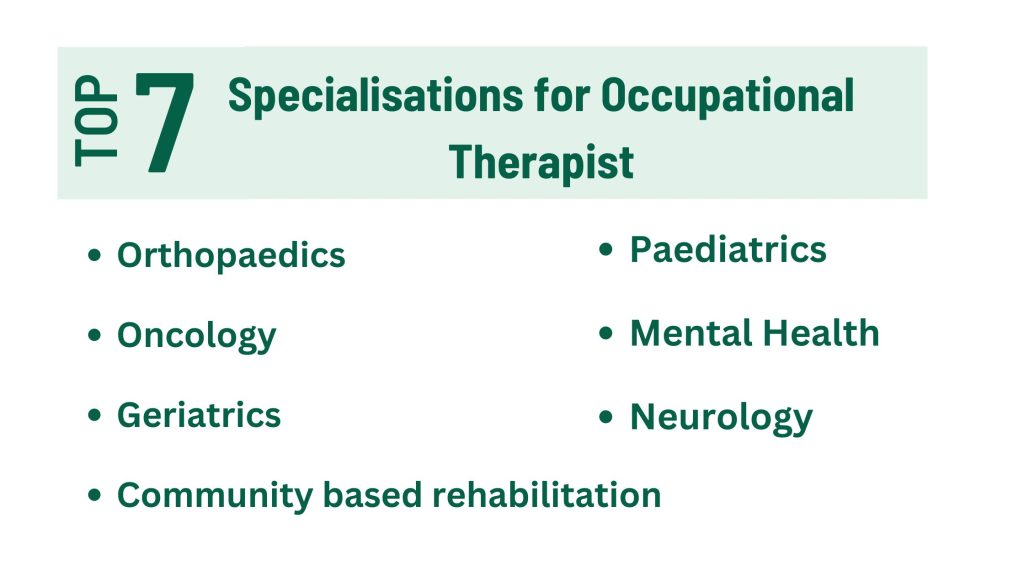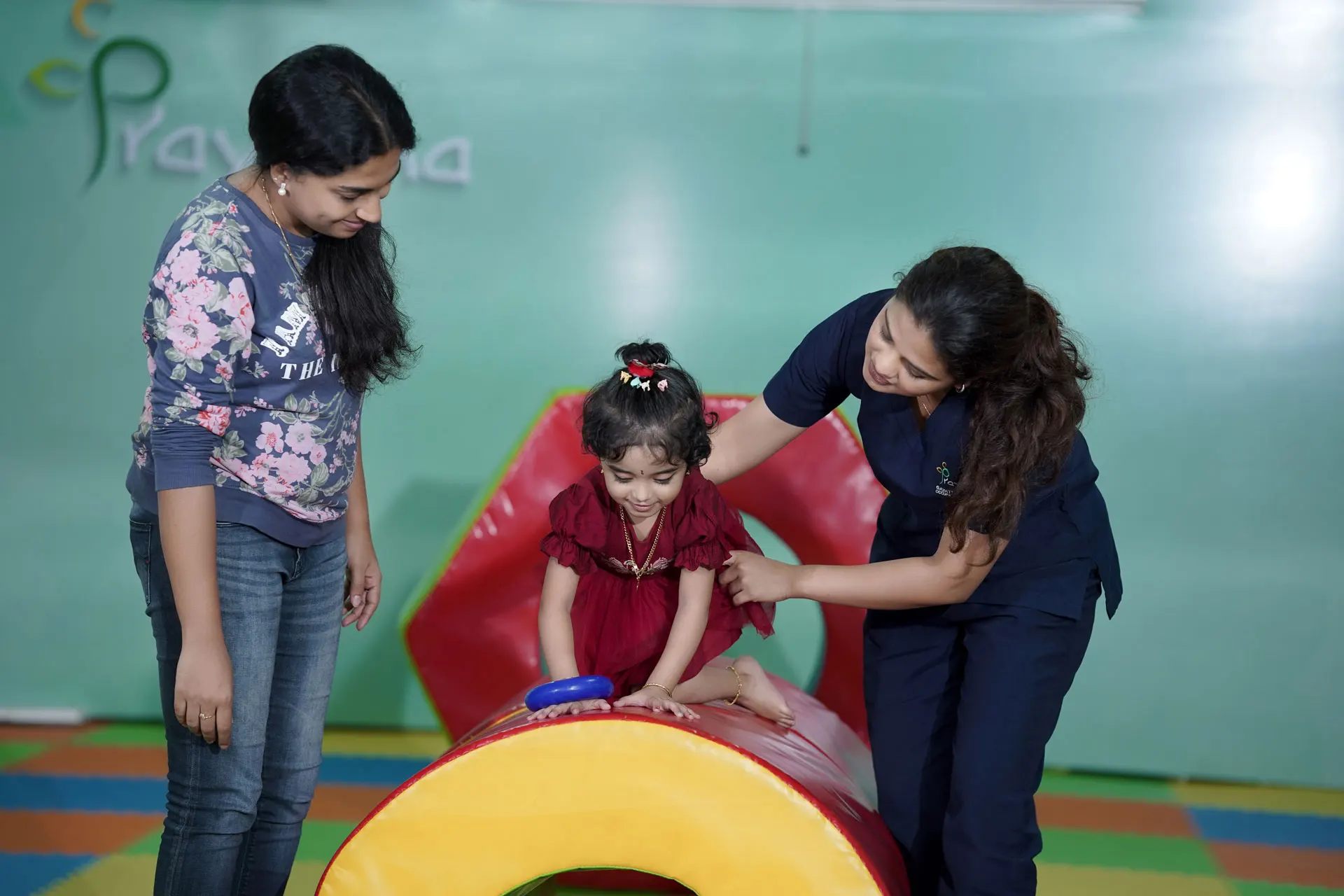
Written by
Silla George, BOT,
Occupational Therapist
All of us love to be functionally independent. But for some people this ability may be disrupted due to disability, injury, illness or a medical condition making it really hard for them to perform their day-to-day activities or occupations. Be it a child or an adult, an occupational therapist can help. But what exactly does an Occupational therapist do? To know further, let’s take a look at
- Who is an Occupational therapist – their duties and responsibilities
- Where do they work and the nature of their work in specific reference to kids at school
Who is an Occupational Therapist?
An Occupational therapist is a trained and licensed healthcare professional who is committed to make a positive impact in the lives of the people they treat. They are skilled in assessments and treatment of individuals whose abilities in performing their occupations (self-care, academics, play, sleep, work and leisure) are limited or impaired by physical, cognitive, mental, developmental, emotional disorder or old age ailments / problems. An Occupational therapist uses purposeful activities and adaptive equipment to maximise a patient’s independence while preventing disability and maintaining his/her health.
In India, an occupational therapist is one who is trained in Occupational therapy with educational qualification of BOT/MOT/PhD and registered and licensed under AIOTA.
Suggested Reading: Occupational Therapy: Everything you need to know – A Definitive Guide
Is occupational therapist a doctor?
Occupational therapists are allied health professionals and they are involved in the crucial part of the treatment of a patient.
What exactly does an occupational therapist do?
An Occupational therapist uses therapeutic techniques and works one-on-one with clients to rehabilitate them, maintain their ability to perform everyday activities and overcome their barriers in the social and physical environment.
OTs focus on a holistic approach taking into consideration – the person, the occupation they do and the environment they perform the occupation, to improve client’s quality of life rather than treating a particular dysfunction or disability solely.
- Occupational therapists work with people of all ages – from premature babies to young children, adults, and senior citizens.
- Therapists make changes to the work environment or modify the method of work to help an individual return to his/her workplace.
- OTs also recommend adaptations and/or assistive devices to reduce environmental barriers in order to encourage an individual to participate in his/her daily activities independently.
- At preschool / school the therapist assists in child development. They also provide information about the child’s abilities and changes to be done in the classroom environment to enhance his/her functioning.
- They work with the elderly to lessen the struggles due to ageing and help them live life more comfortably.
If you want to know more about role and duties of Occupational Therapist please read this blog
Roles and Duties of an Occupational Therapist
An Occupational therapist’s work involves a broad array of tasks and duties. Here’s a breakdown of their key roles and responsibilities
- Evaluation of a client’s condition and skill needs
- Assess the client’s home / work / school environment
- Develop a therapy plan, set realistic goals based on their needs, administer therapy activities and help them meet specific goals
- Collaborate with other professionals such as doctors, allied health professionals, teachers, special educators as well as patient’s family members
- Keep records updated, write reports, document progress and give home programs
- Attend multidisciplinary case meetings to discuss, plan and review ongoing treatment
- Recommend home programs /adaptations /special equipment to improve independence and train the clients and their caregivers
Where Do OTs Work?
OTs work with children and adults of all age categories treating a wide range of conditions. They work as in-house therapists or consultants in different settings including,
- Early intervention centres, Child development centres and Rehabilitation centres.
- Multispecialty Hospitals – in orthopaedics, neurology, mental health, paediatrics and oncology
- Private Practice – independent occupational therapist
- Private clinics.
- Mental health clinics / Mental institutions
- Geriatric homes/Old age homes
- Burns, spastic and leprosy centres
- Industrial workplace
- Sheltered workshops – A supportive environment that employs the mentally and physically challenged to acquire job skills and vocational training
- Special schools /Special Needs Schools
- Schools
- Non-Governmental Organisations (NGOs)
- Community Health Centres
- Half way homes – A temporary place, where the patients stay for a short period before facing the outside world, after they are discharged from hospital
- Home healthcare services – occupational therapist work in their patient’s homes to help them live independently
- OT institutions
- Lecturers in Medical Colleges
What does an occupational therapist do in school?
- Occupational therapists work with children in preschools and schools from kindergarten to middle school to high school.
- They observe the children and evaluate their performance at school.
- Occupational therapists work collaboratively with other health care professionals, teachers and parents.
- For the children who are in need, Occupational therapist sets academic and non-academic goals, modifies the environment and provides occupational therapy program to help them learn, play and interact.
- OTs help children with issues in handwriting, reading skills, cognitive skills, gross motor skills, fine motor skills, balance and coordination, play skills and sensory processing skills. They also attend to difficulty in strength and stability in shoulders and wrist to write. They help kids with problems in self-regulation, peer interaction and social interaction.
- OTs help in toilet training, self-feeding, dressing and improving oral motor skills as well.
- OTs also help to create good ergonomics, modify the mobility aids or toys in school.
Suggested Reading: Occupational Therapy Activities for Kids
Specialisations for Occupational Therapist
Occupational therapists specialize in different areas such as,

- Paediatrics
- Mental Health
- Neurology
- Orthopaedics
- Oncology
- Geriatrics
- Community based rehabilitation
After completing graduation in Occupational therapy, most pursue post graduation and specialize in specific areas while some do additional certifications in specified areas such as assessments or treatments like sensory integration therapy, aquatic therapy etc. to get a broader perspective of the process and improve treatment prospects.
Conclusion
An occupational therapist sees an opportunity in every difficulty thereby blossoming hope everywhere.
Occupational therapists deal with different kinds of patients with mental and physical disabilities. In the process of treatment, they encompass all aspects of the individual – be it physical, psychological, environmental or social with the objective of helping the patient live his/her life to the fullest.

